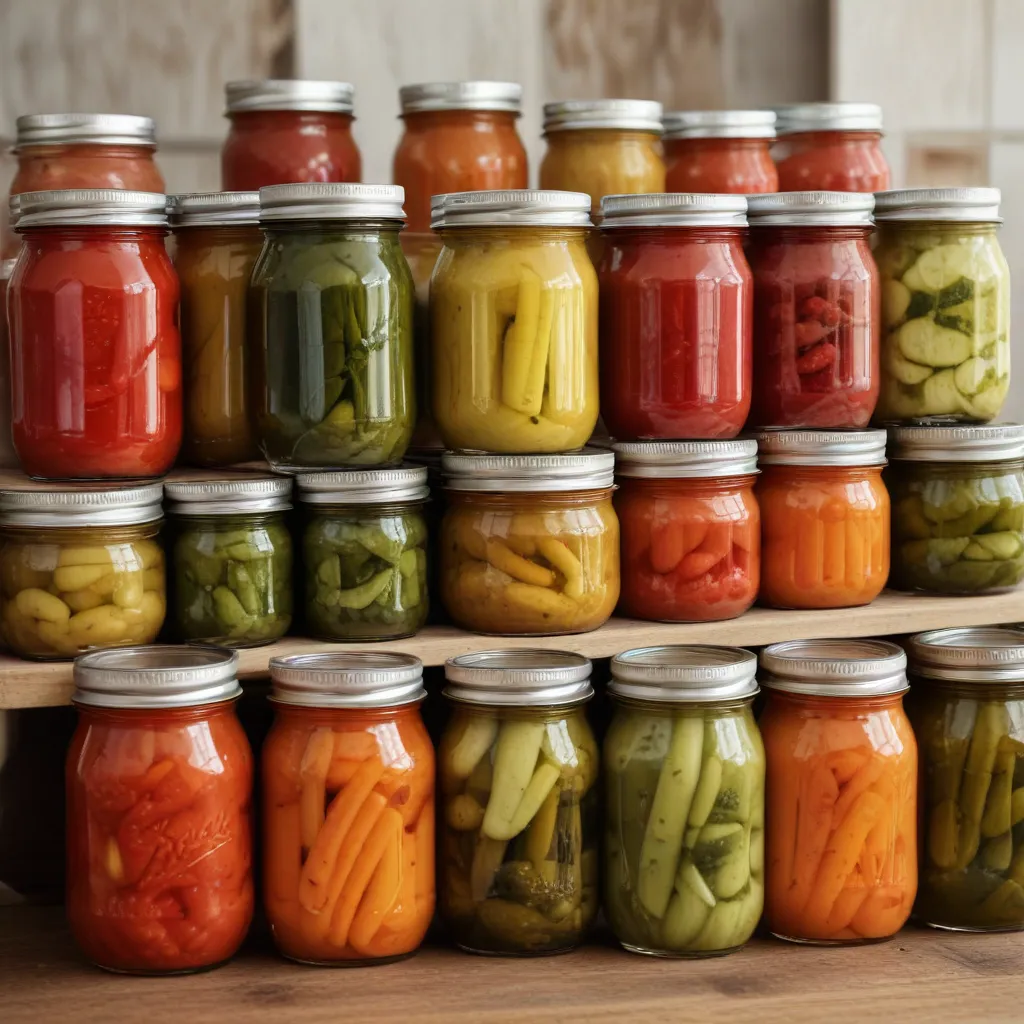
Preserving the Harvest: Canning and Pickling Farmhouse Favorites
As the days grow shorter and the air turns crisp, the bounty of Crooked Pines Farm is in full swing. From the vibrant tomato vines to the crunchy cucumber patches, our garden is brimming with the flavors of the season. But these fleeting delights needn’t disappear with the frost. By mastering the timeless arts of canning and pickling, we can preserve the harvest and savor it long after the last leaves have fallen.
Canning Techniques
Canning is a versatile preservation method that allows us to lock in the freshness and nutrition of our garden’s offerings. There are two primary canning techniques to consider: water bath canning and pressure canning.
Water Bath Canning
For high-acid foods like tomatoes, peaches, apples, and pickles, a simple water bath canner is all you need. By submerging jars in boiling water, you can raise the internal temperature to 212°F, effectively halting the growth of molds, yeasts, and bacteria that cause spoilage. This method is straightforward and requires minimal specialized equipment.
Pressure Canning
Low-acid vegetables, such as green beans, carrots, beets, and corn, require a more robust approach. Pressure canners use pressurized steam to reach the critical temperature of 240°F, ensuring the complete destruction of harmful microorganisms. While this method requires a bit more setup, it’s an essential tool for safely preserving the nutritious bounty of your garden.
Safely Canning Produce
Regardless of the canning technique, it’s crucial to follow recipes and guidelines to the letter. Any deviations in ingredients or processing can impact the acidity level and jeopardize food safety. Consult trusted sources like the Ball Blue Book of Preserving for up-to-date, tested recipes that ensure the highest standards of quality and safety.
Pickling Fundamentals
Pickling is another time-honored way to extend the life of your garden’s harvest. There are two primary pickling methods to consider: vinegar-based pickles and fermented pickles.
Vinegar-Based Pickles
Vinegar-based pickles are the quickest and easiest option. By submerging your produce in a solution of vinegar, salt, and seasonings, you can create a shelf-stable product that can be enjoyed for up to a year. The key is to use a high-quality distilled white vinegar with at least 5% acidity. Avoid using apple cider or wine vinegars, as their lower acidity levels can compromise food safety.
Fermented Pickles
For a more complex flavor profile, consider fermenting your pickles. This age-old technique relies on lactobacillus, a beneficial bacteria that transforms the sugars in your produce into lactic acid, creating a tangy, crunchy delight. Fermented pickles require a bit more hands-on attention, but the resulting probiotics and depth of flavor are well worth the effort.
Pickle Recipes
Whether you prefer the classic dill or a fiery jalapeño, there’s a pickle recipe to suit every palate. Consider experimenting with a variety of vegetables, spices, and flavors to find your family’s favorites. And don’t be afraid to let your creativity shine – just be sure to stick to tested recipes when it comes to the crucial elements of acidity and safety.
Farmhouse Favorites
Beyond the humble pickle, canning can unlock a world of delectable farmhouse favorites to enjoy year-round.
Tomatoes and Salsa
Perfectly ripe tomatoes are a summer staple at Crooked Pines Farm. Canning them allows us to capture the essence of the season, whether in the form of tomato sauce, salsa, or crushed tomatoes. These versatile pantry staples can elevate countless dishes, from hearty soups to zesty pasta sauces.
Pickled Vegetables
Crunchy pickled cucumbers, tangy pickled onions, and vibrant pickled beets are staples in our farmhouse kitchen. Not only do they add a flavorful punch to salads, sandwiches, and charcuterie boards, but they also provide a nutritious boost of probiotics thanks to the fermentation process.
Fruit Preserves
For a sweet touch, don’t overlook the bounty of our orchard. Jams, jellies, and fruit butters made from freshly harvested apples, peaches, and berries are the perfect companions to hot biscuits, pancakes, or a slice of homemade bread. Canning these delights ensures we can savor the flavors of summer well into the colder months.
Equipment and Safety
Successful canning and pickling require a few essential tools, as well as a keen eye for food safety.
Canning Supplies
At the heart of any canning operation are the jars, lids, and rings. Carefully examine each one, ensuring they are free of cracks or chips that could compromise the seal. Specialty tools like jar lifters, funnels, and magnetic lid wands can also streamline the process.
Food Safety
Maintaining the proper acidity and pH levels is crucial for preventing the growth of harmful bacteria like botulism. Refer to reputable sources and follow recipes to the letter, as any deviations in ingredients or processing can jeopardize the safety of your preserved goods. Properly storing your canned and pickled items in a cool, dark place is also key to ensuring they remain fresh and delicious.
Flavor Profiles
As you embark on your canning and pickling adventures, don’t be afraid to experiment with a variety of flavors and techniques.
Classic Farmhouse Flavors
Embrace the timeless essences of the countryside by incorporating fragrant herbs like dill, thyme, and rosemary, or warming spices such as peppercorns, mustard seeds, and bay leaves. These classic farmhouse flavors can transport you straight to the heart of the harvest.
Fermentation Flavors
For a more complex, tangy profile, explore the world of lacto-fermentation. Incorporating ingredients like garlic, chili peppers, and ginger can create a dynamic flavor profile, while the natural probiotic content provides an added nutritional boost.
As you delve into the art of canning and pickling, let your senses guide you. Experiment with regional influences, seasonal offerings, and your own family’s beloved recipes to craft a truly unique and satisfying pantry. With a little time, care, and the bounty of Crooked Pines Farm, you can enjoy the harvest’s finest well into the winter months.


